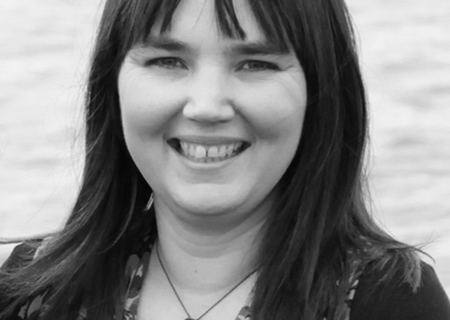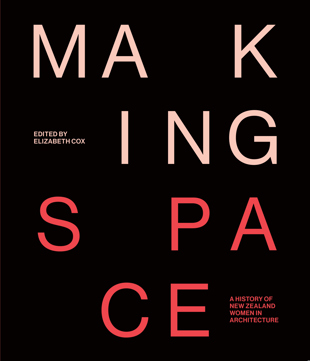Q1: This is a major project, and you already had a big day job! Where did the idea come from, and how did you keep driving yourself forward on it?
I studied women’s history at university but since then I have spent two decades working in the heritage sector and writing about architecture and heritage, so this project just seemed perfect. I found a woman listed in the appendix of a book about architects from 1840 to 1940 in Wellington – the only woman in the book – and I put a bookmark on her page and tracked down her life story, and it all grew from there.
History often isn’t really a collaborative sport, but architecture is, so I took inspiration from the profession and pushed myself to work with others who knew the profession better than I did, which is how the project grew and grew, and ended up with 30 women writing for the book in total.
Q2: You are not an architect yourself. Did that matter?
There is something to be said for being an outsider and having that outsider perspective – and historians are obviously used to be outsiders to the people we are writing about! But also I had so many conversations with architects and did a major oral history project to try and get their perspective – and the authors who were architects also pushed me to understand the profession better.
Q3: This project had some key allies. Who came on board early to give it impetus?
The women of the group Architecture+Women NZ, which works to make the profession a better place for women (and for all!), came on board very early and supported the project. It was pretty special how they embraced me and the project. But also Mary-Jane Duffy, one of the few people who had done a lengthy study of a New Zealand woman architect in the 1990s, who wrote about Christchurch architect Margaret Munro, talked to me about meeting Margaret. So she was able to give me a connection to someone who was working in the profession as early as the 1930s. Mary-Jane had also corresponded with some of those retired women architects who were still around in the 1990s who are not here any more, so her research was really valuable. I was really pleased that she agreed to write about Margaret all these years later for the book.
Q4: You enlisted the help of an impressive crew of writers, who are also all busy women. What drove them to agree to be involved?
There is a mixture of architects, academics and architectural historians, all women. Lots of them wrote about their own fields and specialisms which was so great, for example Divya Purushotham from Warren + Mahoney, who designs really large commercial buildings, wrote about her peers, other women who do the same, which I think is pretty special. A lot of work went into those chapters dealing with women currently working in the profession - because there are so many now. Dr Karamia Müller, for example, held number of talanoa with the Pacific women architects during the lockdowns and learned about the special challenges and opportunities of those women.
Another example was architect Megan Rule, who only heard about an early women architect who had worked in her own home town when I told her about her, but then embraced the challenge of writing about her, tracking down her buildings and her families. Dr Jessica Halliday wrote about the women involved in the rebuilding of Christchurch: artists, architects, iwi and urbanists all working together to rebuild the city, and I think that was a very personal project for her, to honour all that hard work she had seen around her since the earthquakes.
The book is called Making Space because women were making physical spaces, while also making space for themselves within the profession. But a third meaning of the book became clear to me as I was working with everyone to put their chapters together - that the book itself was making a space for women to write and think about their profession and their experiences in it, and to have hundreds of conversations about architecture with their peers.
Q5: It must have given you enormous satisfaction to see the stories of pioneers like Kate Beath, Lucy Greenish, Florence Field, Alison Sleigh, Muriel Lamb and Monica Barham being told at long last.
It has been such an honour to bring some of those stories out into the light, and I am sure people will bring me more now the book is published. These early women showed me that actually there were women working the profession for many years, it was just that no-one really knew. I’m also especially proud of having three chapters written by Māori women and one by a woman from the Pacific, talking about their colleagues in the profession and their work; it has been a real honour to work with them and to provide them with a venue to bring those stories to light.
Q6: Whose story in particular made a mark on you?
Definitely Lucy Greenish, whose story helped kick off this project, who was the first registered woman architect in New Zealand, who had many trials and tribulations in her life, but still battled on to set up her own firm. I was still finding out more about Lucy right up until the book was about to go to print, but I still feel like there is more to learn about her, and the lack of evidence for the buildings she actually designed is really frustrating. But her persistence in the face of war and personal set backs shines through. But there were lots of others in those early days with similar stories of persistence in the face of real difficulties.
Q7: There is no doubt that achieving a fulfilling professional life it has been a struggle for many women architects, especially those who have wanted also to raise a family. Do those struggles continue?
Things have got noticeably better for women architects, even in the last five to ten years. I think also that Covid probably helped, as it convinced architectural firms that it is possible for people to work at home, as has the hard work of both women and men to make the profession a better place to be for many years. It has been slower than lots of other professions to embrace flexible work, which has kept women from achieving all they could have, and there is still a way to go in this regard. The crucial thing to remember is that the ability to access flexible and part time work is important for both men and women, and the profession must continue to support it.
Q8: What’s one new thing you learned while working on this book?
I think I got a much better perspective on the ways in which New Zealand architecture firms functioned, particularly in the early twentieth century. I was struck by the number of really well known architects and firms who employed draughtswomen and architects in those firms, and their work is rarely acknowledged. I was so happy when I found a series of photos of Lucy Greenish working in a Wellington firm, in her office, at her drawing board, discussinh her work with an architect colleague – that was pretty special.
Secondly, because I was reviewing the work and workers in one profession over a period of 120 years, something that struck me was the difference that the state of the economy can make to vulnerable people within a profession, especially women. The situation for one group of women and their careers could be strikingly different depending on what cycle of the economy they graduated into, compared to their sisters even five years later or earlier. But, often, those women who graduated in difficult circumstances, such as war or recession, were those who went on to come up with creative solutions to keep going in their profession. This carried on today of course, and because I was writing and interviewing during Covid, it was striking how scary it was for so many firms during those early days.
Q9: What do you hope female students at architecture school right now will take from this book?
I’m told that many young women don’t find gender to be an issue so much at university, because the numbers are much more 50/50 nowadays - that it is when they make it into the workforce that things can become hard. So perhaps by reading this book they will be given a perspective that shows them that gender, cultural and other types of diversity is important, but in a good way. Elisapeta Heta, kaihautū whaihanga — Māori design leader at Jasmax, has talked about architects and other urban professionals needing ‘to get comfortable with multiple world views coexisting’, for the good of our urban spaces. As architecture evolves and embraces that idea, the potential of women architects and architects from other cultures and backgrounds will continue to be unlocked, to the benefit of the profession and of our built environment. So those young women currently at university are going to have so much of a chance to be a force for great things. And also of course– hopefully the book will give them the confidence that plenty of women have been there before them and that they can do it too.
Q10: And the profession, and the general public interested in architecture?
I am hoping when people read the book that it becomes clear that women have been there in the profession all along, right from its earliest days of the professionalism of the architectural workforce, designing our built and urban environments and landscapes, and that while they were doing all that they were also fighting to making a space for themselves in what was a very gendered profession. But also, I hope they learn not just about the historical women but the hundreds of women working in the profession today and the amazing work they do.


